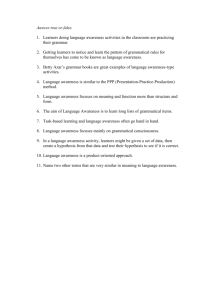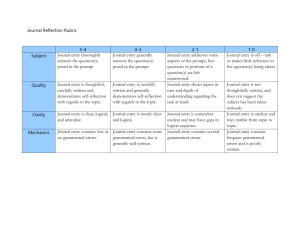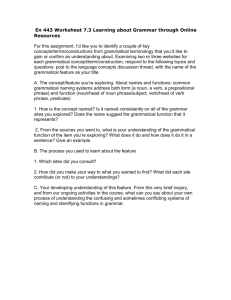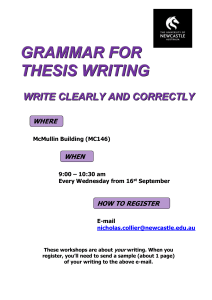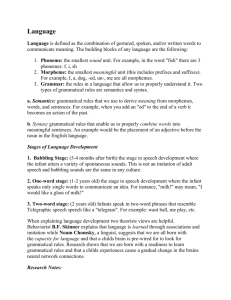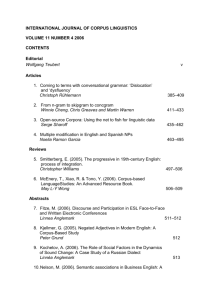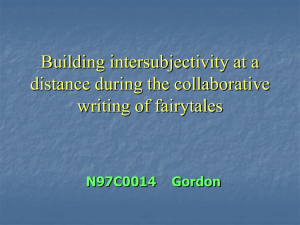The various incarnations of cognitive linguistics can be
advertisement
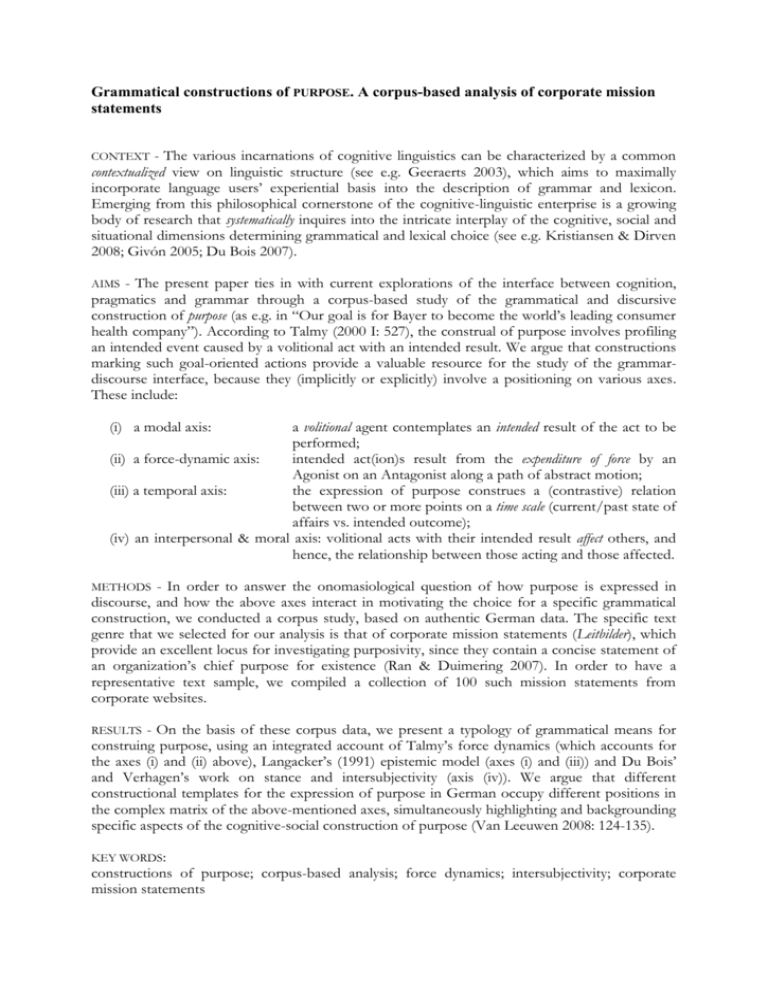
Grammatical constructions of PURPOSE. A corpus-based analysis of corporate mission statements - The various incarnations of cognitive linguistics can be characterized by a common contextualized view on linguistic structure (see e.g. Geeraerts 2003), which aims to maximally incorporate language users’ experiential basis into the description of grammar and lexicon. Emerging from this philosophical cornerstone of the cognitive-linguistic enterprise is a growing body of research that systematically inquires into the intricate interplay of the cognitive, social and situational dimensions determining grammatical and lexical choice (see e.g. Kristiansen & Dirven 2008; Givón 2005; Du Bois 2007). CONTEXT - The present paper ties in with current explorations of the interface between cognition, pragmatics and grammar through a corpus-based study of the grammatical and discursive construction of purpose (as e.g. in “Our goal is for Bayer to become the world’s leading consumer health company”). According to Talmy (2000 I: 527), the construal of purpose involves profiling an intended event caused by a volitional act with an intended result. We argue that constructions marking such goal-oriented actions provide a valuable resource for the study of the grammardiscourse interface, because they (implicitly or explicitly) involve a positioning on various axes. These include: AIMS (i) a modal axis: a volitional agent contemplates an intended result of the act to be performed; (ii) a force-dynamic axis: intended act(ion)s result from the expenditure of force by an Agonist on an Antagonist along a path of abstract motion; (iii) a temporal axis: the expression of purpose construes a (contrastive) relation between two or more points on a time scale (current/past state of affairs vs. intended outcome); (iv) an interpersonal & moral axis: volitional acts with their intended result affect others, and hence, the relationship between those acting and those affected. - In order to answer the onomasiological question of how purpose is expressed in discourse, and how the above axes interact in motivating the choice for a specific grammatical construction, we conducted a corpus study, based on authentic German data. The specific text genre that we selected for our analysis is that of corporate mission statements (Leitbilder), which provide an excellent locus for investigating purposivity, since they contain a concise statement of an organization’s chief purpose for existence (Ran & Duimering 2007). In order to have a representative text sample, we compiled a collection of 100 such mission statements from corporate websites. METHODS - On the basis of these corpus data, we present a typology of grammatical means for construing purpose, using an integrated account of Talmy’s force dynamics (which accounts for the axes (i) and (ii) above), Langacker’s (1991) epistemic model (axes (i) and (iii)) and Du Bois’ and Verhagen’s work on stance and intersubjectivity (axis (iv)). We argue that different constructional templates for the expression of purpose in German occupy different positions in the complex matrix of the above-mentioned axes, simultaneously highlighting and backgrounding specific aspects of the cognitive-social construction of purpose (Van Leeuwen 2008: 124-135). RESULTS KEY WORDS: constructions of purpose; corpus-based analysis; force dynamics; intersubjectivity; corporate mission statements REFERENCES Du Bois, John W. 2007 The stance triangle. In: R. Engelbretson (Ed.), Stancetaking in Discourse: The Intersubjectivity of Interaction. Amsterdam: Benjamins, 139-182. Geeraerts, Dirk 2003a Decontextualizing and recontextualizing tendencies in 20th-century linguistics and literary theory. In: E. Mengel, H.-J. Schmid & M. Steppat (Eds.), Anglistentag 2002 Bayreuth. Trier: Trier Wissenschaftlicher Verlag, 369–379. Givón, Talmy 2005 Context as Other Minds. The Pragmatics of Sociality, Cognition and Communication. Amsterdam/Philadelphia: John Benjamins. Kristiansen, Gitte & René Dirven (Eds.) 2008 Cognitive Sociolinguistics: Language Variation, Cultural Models, Social Systems. Berlin: Mouton de Gruyter. Langacker, Ronald W. 1991 Foundations of Cognitive Grammar. Volume 2: Descriptive Application. Stanford (Ca.): Stanford University Press. Ran, Bing & P. Robert Duimering 2007 Imaging the organization: Language use in organizational identity claims. Journal of Business and Technical Communication 21-2: 155-187. Talmy, Len 2000 Toward a Cognitive Semantics. Volume 1. Cambridge (Mass.): MIT Press. Van Leeuwen, Theo 2008 Discourse and Practice. New Tools for Critical Discourse Analysis. Oxford: Oxford University Press.



